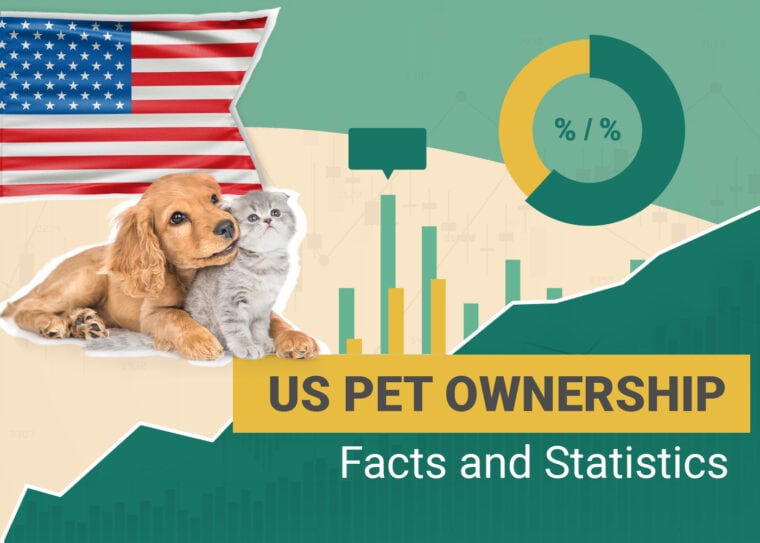
Click to Skip Ahead
Note: This article’s statistics come from third-party sources and do not represent the opinions of this website.
People in the United States are fascinated by their pets, and most will agree that more and more people are getting them every day. While the benefits of owning pets are well-known and widely studied, life during a global pandemic has caused many to rely even more on their animals to cope. There are roughly 5 million U.S. homes with one or more pets.
When it comes to pet ownership, if you want to know what the numbers have to say, you’ve come to the right place. In this article, we’ll reveal 20 pet ownership statistics to know for this year, as well as answer some general questions about owning pets in the US including:
The 20 US Pet Ownership Statistics
- 89 million U.S households own at least one pet.
- 60% of US pet owners are female.
- Millennials are the generation most likely to own pets, accounting for 32% of all pet owners.
- Approximately 23 million US households added a pet between March 2020 and May 2021.
- About 69 million households in the US own at least one dog.
- Roughly 45.3 million US households own at least one cat.
- Americans owned an average of 1.46 dogs per household in 2020.
- 36% of dogs were purchased from breeders between March 2020 and May 2021.
- 33% of cats were acquired from friends, relatives, or neighbors during the same period.
- The Labrador Retriever is the most popular dog breed in America, with 98,300 registered in 2020.
- Freshwater fish are the third most popular pet in the US, owned by 11.8 million households.
- Saltwater fish are the least popular pets, found in 2.9 million households.
- 85% of dog owners and 76% of cat owners consider their pets family.
- The state with the highest rate of pet ownership is Wyoming at 72%.
- The rate of pet ownership is highest among people living in mobile homes at 73.8%
- The percentage of poultry kept as pets increased by 23% between 2012-2017.
- Approximately 6.3 million cats and dogs wind up in US animal shelters each year.
- There are between 30-40 million community cats in the US
- 90% of dogs and 87% of cats adopted during the pandemic were still with their owners in May 2021.
- Approximately 390,000 dogs and 530,000 cats are euthanized in US shelters annually.
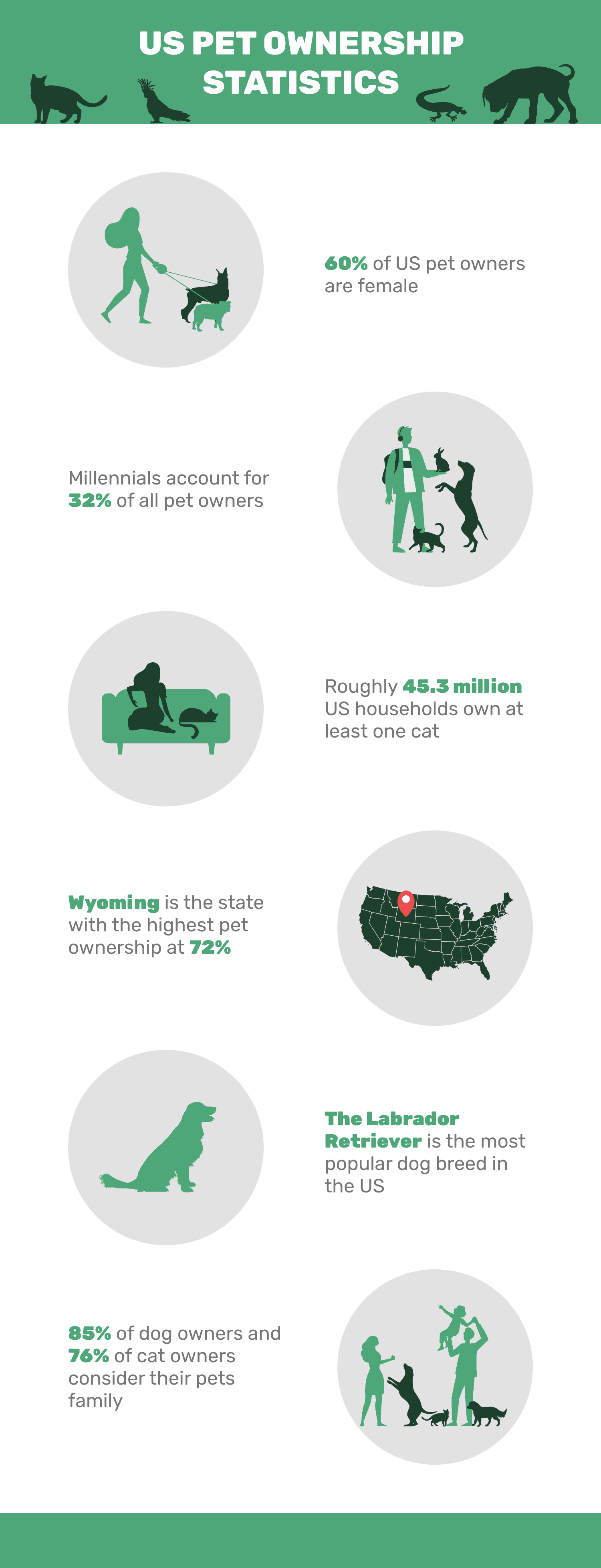
Who Owns Pets In The U.S?
1. 66% of U.S. households (86.9 million homes) own a pet.
(APPA)
This number represents 70% of all US households. In 1988 (the first year of the APPA survey), 56% of US households owned pets.
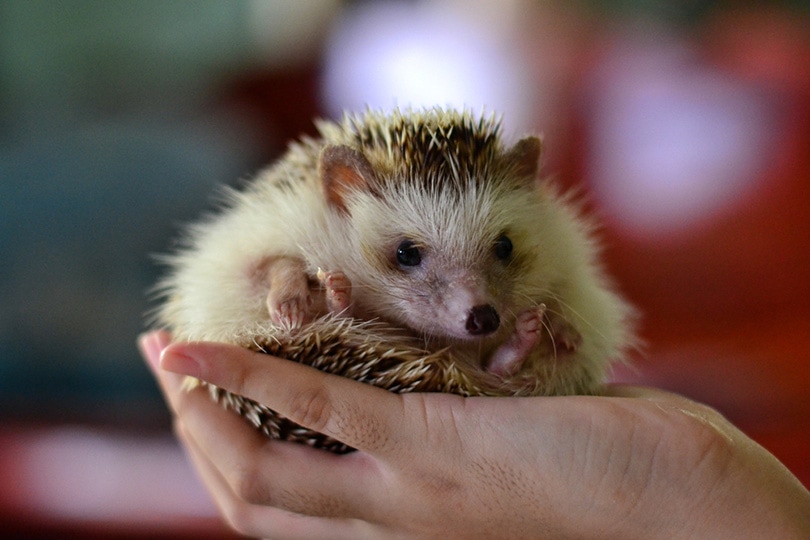
2. 60% of US pet owners are female.
(Infogroup)
This data came from an analysis of 50,000 pet owners and product buyers in 2020. This same data found that 55% of pet owners purchased women’s clothing, 36% purchased home decor products, and 29% purchased housewares. Females dominate not only US pet ownership but pet spending as well.
3. Millennials are the generation most likely to own pets, accounting for 32% of US pet owners.
(APPA)
Baby boomers are next on the list, at 27% of US pet owners, followed by Gen X at 24%. Gen Z accounts for 14% of pet owners, with Builders equaling 3%.

4. Approximately 23 million US households acquired a pet during the pandemic (March 2020-May 2021).
(ASPCA Survey)
This number represents about 1 in 5 of the total households in the US, based on the 2019 census. 32% of those new pet owners worry that they won’t be able to afford their pet in the future, with 25% specifically worried about affording veterinary care.
What Kind Of Pets Do They Own And Where Do They Live?
5. About 69 million households in the US own at least one dog.
(APPA)
Dogs are the most popular pet in the United States. About 24 million more households in the US own dogs than cats.

6. Roughly 45.3 million US households own cats.
(Insurance Information Institute)
The number of cat households in the US has remained relatively static, while dog-owning households have increased.
7. Americans owned an average of 1.46 dogs per household in 2020.
(AVMA)
This represents a decrease from the 1.6 dogs per household average in 2016. While the number of people owning dogs increased, the number of dogs they owned declined. About 65% of dog-owning households owned just one dog, compared to 60% in 2016.

8. 36% of dogs were purchased from breeders between March 2020 and May 2021.
(Frontiers)
Based on this statistic, it appears that most of the “pandemic pups” came from breeders, rather than animal shelters. In 2017-2018, before the pandemic, 29% of dogs were purchased from pet stores or breeders. This is also impacted by the fact that fewer animals were available in shelters during the pandemic.
9. 33% of cats were acquired from friends, relatives, or neighbors from March 2020 to May 2021.
(Frontiers)
In contrast, the “pandemic cats” primarily came from individuals known to the new owners. Before the pandemic, 37% of cats were adopted from shelters, and 26% came from individuals. About 19% of pandemic cats came from breeders, compared to only 5% from breeders and pet stores combined in 2017-2018.

10. Labrador Retrievers are the most popular purebred dog in the US, with 98,300 registered in 2020.
(NPR)
Labradors have been the most popular breed in America for 30 years. Registered Labs outnumbered the second place breed—French Bulldog—by about 30,000 dogs. Clearly, the Labrador’s grip on the top spot is in no danger of slipping.
11. Freshwater fish are the third most popular type of pet in the US, owned by 11.8 million households.
(Insurance Information Institute)
This category is also the fastest-growing among pet types in the US. About 2 million more households own fish than do the next highest category, birds.
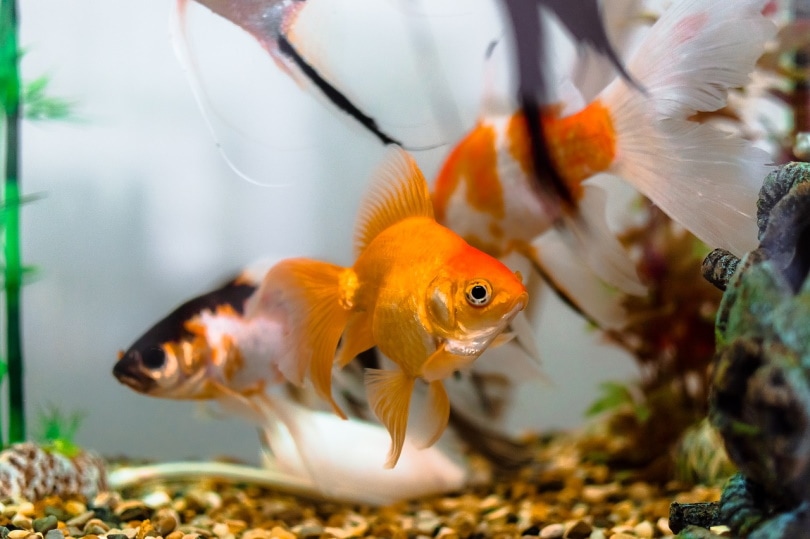
12. Saltwater fish are the least popular pet type in the US, found in 2.9 million households.
(Insurance Information Institute)
Saltwater fish come in just below horses in popularity, 3.5 million to 2.9 million. Compared to freshwater fish, saltwater specimens are more difficult to care for, perhaps explaining the vast popularity gap between the two.
13. 85% of dog owners and 76% of cat owners consider their pets family.
(Phys)
Not only are pets considered family, but pet owners—especially younger ones—are making big life decisions, such as buying a house with their pet’s needs taken into account. Young pet owners are also more likely to view owning a pet as a substitute for a human child.

14. The state with the highest rate of pet ownership is Wyoming, with 72% of all households owning pets.
(AVMA Sourcebook)
This data comes from 2016, based on figures from the 2017-2018 AVMA Pet Ownership Sourcebook, which is only published every 5 years. The state with the lowest rate of pet ownership is Rhode Island at 45%, although the District of Columbia is the true lowest at 38%.
15. The rate of pet ownership is highest among people living in mobile homes, at 73.8%.
(AVMA Sourcebook)
The lowest rates of pet ownership were among people living in apartments and condos. Closely related to these findings, the Sourcebook also noted that people living in cities had the lowest rates of pet owners. The highest rates were among those living in rural areas or near small cities (less than 100,000 people).
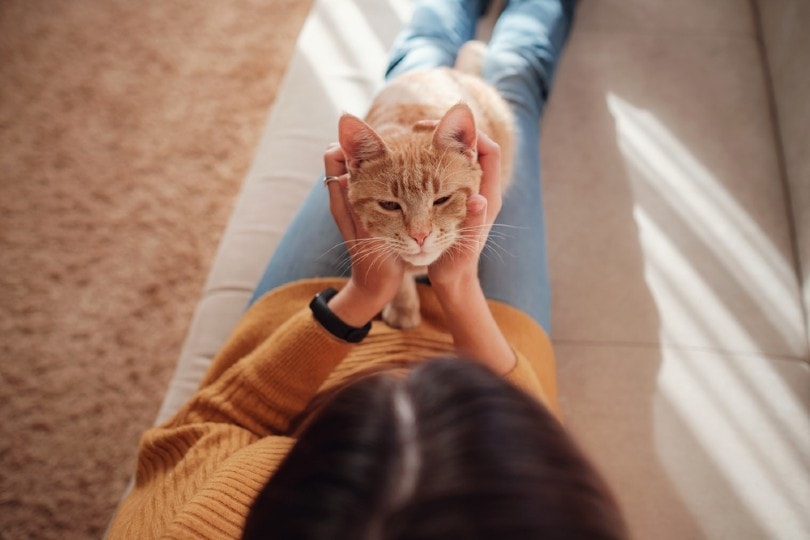
16. The percentage of poultry kept as pets increased by 23% between 2012-2017.
(AVMA Sourcebook)
This data likely reflects the rise in backyard chicken keepers. It will be interesting to monitor this statistic in the next AVMA sourcebook to see how the pandemic impacted this number. Anecdotally, homesteading-type activities like gardening and keeping chickens seemed to grow in popularity but we will need to wait for the data to be sure.
The Dark Side Of US Pet Ownership
17. Approximately 6.3 million cats and dogs wind up in US animal shelters each year.
(ASPCA)
These numbers are almost evenly divided between the two, 3.1 million dogs and 3.2 million cats. Pet problems, including problem behavior, aggression, health costs, and the size of the animal are the most common reason(s) people surrender their pets.

18. There are between 30-40 million community cats in the US
(Humane Society)
This term describes stray, feral, or fed cats who live outdoors in communities throughout the country. About 10% of Americans regularly feed outdoor cats they don’t claim to own. Strategies such as Trap-Neuter-Return (TNR) and wildlife protection are used to manage these cat communities because they’re so large.
19. 90% of dogs and 87% of cats adopted during the pandemic were still with their owners as of May 2021.
(Frontiers)
Despite concerns that pandemic adoptions occurred on a whim and would result in the mass return of animals to shelters, the data doesn’t support this fear, which is encouraging. However, 9% of pandemic adopters expressed concern that they would need to rehome their pets within 3 months after the survey ended. Financial insecurity and concern over losing housing were common reasons cited.

20. Approximately 390,000 dogs and 530,000 cats are euthanized in US shelters each year.
(ASPCA)
Despite entering shelters at similar rates, cats are more likely than dogs not to make it back out. This alarming number has also declined significantly since 2011 when the rate was 2.6 million dogs and cats euthanized annually. Adoption rates have increased over the years and shelters have become more successful at reuniting lost pets with their owners.
Frequently Asked Questions About US Pet Ownership
How can I help decrease the rate of animals euthanized in shelters?
Though the euthanasia rate has been declining over the past 10 years, nearly one million lost and unwanted pets still lose their lives each year. You can help prevent more homeless pets by spaying and neutering your own dogs and cats. Adopting a new pet rather than buying from a pet store or breeders is another helpful option.
To decrease the chances of your pet getting lost, make sure they are always properly secured when outdoors with fences, leashes, or carriers. Microchip your pets and make sure the chip is registered with your up-to-date contact information. Ideally, cats and dogs should wear collars with ID tags as well.
I think I want to buy an exotic pet. Is it legal in my state?
Good question! The rules regarding exotic pet ownership–even what pets are considered exotics—vary widely, not only by state but even between cities and towns. As of this year, 20 states have comprehensive bans on many exotic pets, including big cats and primates. Thirteen other states have partial bans on owning exotic pets, while 14 require a license or permit to keep many species. The final 3 states have no bans or license requirements but often have some rules in place, such as requiring health certificates.
Before purchasing an exotic pet, check the regulations for your area. And always remember, just because it’s technically legal to own a wild animal doesn’t make it a good idea. These animals belong in the wild and will never be fully domesticated. (Animal Legal & Historical Center)
What is the most pet-friendly city in the US?
According to Forbes magazine, Henderson, Nevada is the most dog-friendly city in the US. The city earned this rank due to the number of dog parks (19!) in city limits, as well as the percentage of pet-friendly rental properties present. The state of Nevada also has legal protections in place for owners of so-called “dangerous” dogs to prevent high insurance premiums and breed discrimination. (Forbes)
Birmingham, Alabama is the most cat-friendly city in America based on metrics like the number of vet hospitals certified by the American Association of Feline Practitioners, number of animal shelters and pet stores, and percentage of cat-friendly rental properties.

How much money do Americans spend on their pets?
In 2021, it’s estimated that Americans spent 109.6 billion dollars on their pets. The highest amount (44.1 billion) was spent on pet food and treats, followed by 32.3 billion for vet care and products. (APPA)
Pet spending increased by about 3 billion from 2020 to 2021 and is expected to continue to rise, especially as more and more young people opt to hold off on having human children and spend money on their pets. The jury’s still out on whether the Pope’s recent disapproval will have any impact on this trend, but given that millennials are also becoming less religious, we guess that it won’t. (Pew Research)
What are the most common health concerns in American pets?
(Trupanion)
Summary
As we see by examining the data, US pet ownership trends show some impacts from the pandemic. However, in many cases, we see trends such as increases in exotic pet ownership, and the overall number of pets in the country have been on a steady upward trajectory over time, not just in the past couple of years.
As more Americans join the ranks of pet owners, we can expect to see increases in demand for pet-related services and products too. American pet owners aren’t just acquiring more companion animals, but are willing to spend more money on them as well. After all, our pets offer unconditional love, and who couldn’t use a little more of that in their lives?
Featured Image Credit: Tatyana Vyc, Shutterstock









